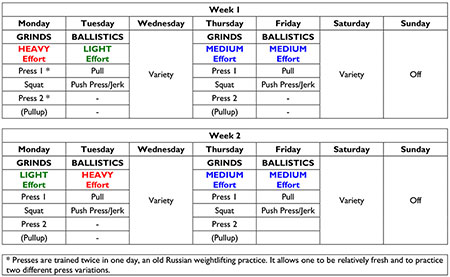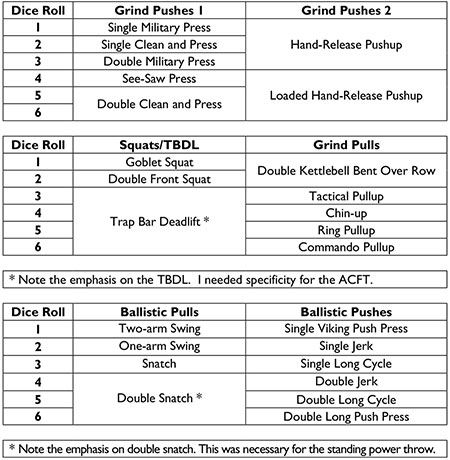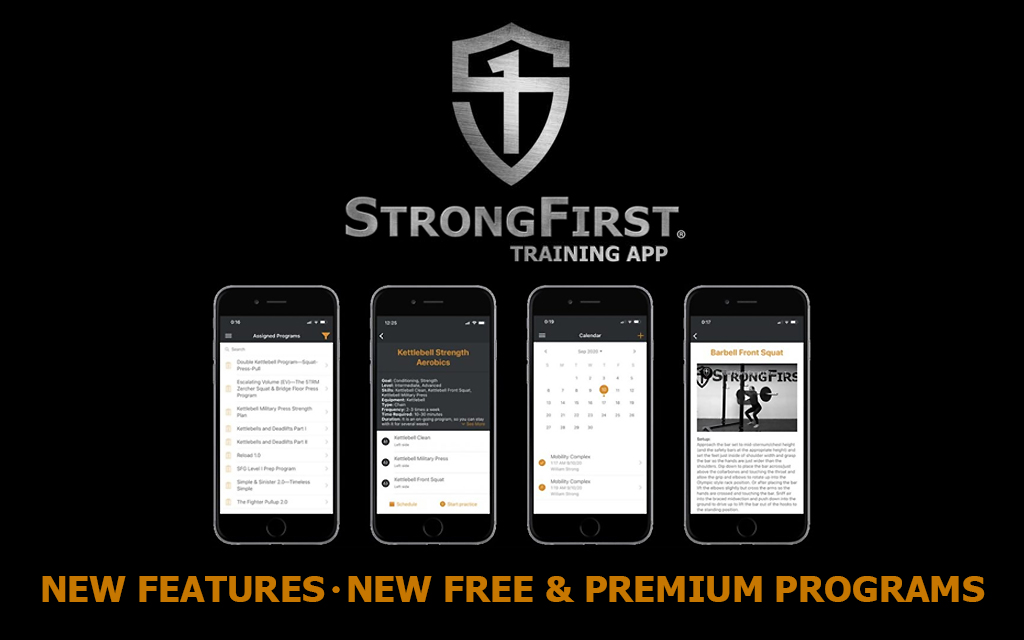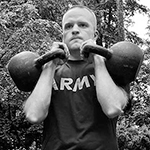
The Fall 2019 implementation of the Army Combat Fitness Test (ACFT) raised many concerns within my unit. The pushup, sit-up, and run events of the old Army Physical Fitness Test (APFT) were replaced by six events: a three-rep max low handle trap-bar deadlift, a standing power throw with a 10lb medicine ball, a two-minute maximum hand-release pushup test, a sprint-drag-carry event, a plank for time, and a two-mile run. The ACFT not only required more long-term preparation than the APFT, but for some, it set very challenging standards. However, due to my experience with StrongFirst programming, I had a much different perspective—this transition was not only easy, but exciting. Below is a program that I created for the ACFT using the Enter the Kettlebell Plus (ETK+) template that Pavel outlined in a 2009 back issue of Milo Magazine.
Background
I am a professional musician and Army bandsman. My experience in the fitness community is limited to reading articles and books, listening to podcasts, studying programs, and discussing details of these with other enthusiasts. The StrongFirst community has been an amazing educational resource not only for me, but for other non-fitness professionals around the world. A special mention must be given to Colin Cooley, former SFG I, who has helped me put much of this information into practice even with my busy schedule.
I am also a husband and father to three beautiful children. My oldest daughter has severe disabilities and special needs, so my stress level changes from day-to-day. My energy must be managed carefully so I can serve my family to the best of my ability. In addition, my job also requires differing levels of stress management making physical, emotional, and mental health essential. For example, I might march five miles in Arlington Cemetery one day, then perform fanfares for foreign dignitaries on the balcony of the White House the next. Because our mission load is too large, my unit does not engage in group physical training. Instead, we are required to complete physical training independently.
My Program
Pavel wrote ETK+ in the December 2009 issue of Milo Magazine (Vol. 17, Number 3). The template and schedule provided can be modified to fit almost any goal. In fact, a search on the StrongFirst forum will provide evidence of the many programs that have developed from it, including my own. This article will share the details and success of my adaptation of ETK+ and provide insight on how you can use it in your own training as well.
I began my program adhering strictly to the original ETK+ schedule for three micro cycles (6 weeks). The original program by Pavel is shown below and can be followed on the StrongFirst Training App.
Warmups consisted of Original Strength resets, get-ups, sled drags, and light mace swings. I usually finished each session with 5-10 minutes of trunk and gait-pattern work such as crawling, weighted planks, carries, and dead bugs. I maintained my aerobic base by taking evening neighborhood walks with my family, while pushing my daughter in her wheelchair.
After following the program strictly for six weeks, I began modifying the template. I replaced four out of the six original squat options for a trap-bar deadlift (TBDL). I included a light (60{32c02201c4e0b91ecf15bfd3deecd875caca8b9615db42cfd45ce3d8de8d0829} 1RM), medium (70{32c02201c4e0b91ecf15bfd3deecd875caca8b9615db42cfd45ce3d8de8d0829} 1RM), and heavy (80{32c02201c4e0b91ecf15bfd3deecd875caca8b9615db42cfd45ce3d8de8d0829} 1RM) day for the TBDL, completing the prescribed ladders. To determine time per exercise, I used the two-dice roll outlined in the program. The dots coincided with minutes; therefore, each exercise lasted 2-12 minutes. Some days I would throw in goblet squats or double front squats, but I mostly performed the TBDL for specificity’s sake.
I also substituted hand-release pushups for one of the press days. For example, on a Monday or Thursday, I would complete the movements in this order: kettlebell press, TBDL/squats, hand-release pushups, and then pullups/rows. Some days (via dice roll), I used a 30lb ruck to add weight to the pushups. The ladders I used were 5, 10, 15, 20 for unweighted and 2, 4, 6, 8 ,10 for weighted. The carryover from pushups was noticeable. My kettlebell press became stronger, and I put on a little muscle in the process.
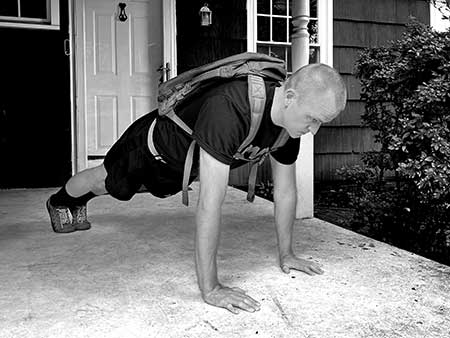
I also used the dice roll outlined in ETK+ to plan the load, duration, and movement for the day. Keeping the loads for each exercise unspecified allowed me to include autoregulation in my training, depending on how I felt that day or what I had planned after my session. Rolling 1-2 meant a light day, 3-4 was moderate, and 5-6 was heavy. To determine time per exercise, I again used the two-dice roll described above. My exercise choices are shown in the tables below.
When time allowed, I substituted sprints/tempo runs into the medium ballistic day for running practice. I based these days on the article, “Tempo Runs + Kettlebells = Your Next “Recovery” Day” by Jeremy Frisch. Wednesdays were usually steady-state days where I would do things like 30-45 minutes of light sled-pulls, rows, jogs, mace swings, club swings, or a ruck. These movements were perfect for recovery and strongly influenced the improvement of my two-mile run time—which surprised me given how little I actually ran.
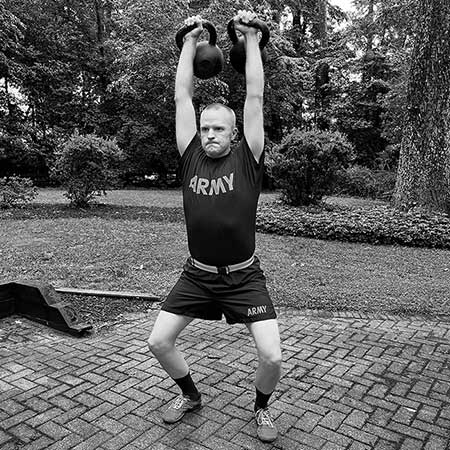
Observations and Results
I could not have been happier with the results of this program. Not only did my ACFT performance improve, but I felt great day-to-day. I wasn’t accustomed to “light” training days. I normally push hard no matter the circumstances, which has led to numerous tweaks and injuries in the past. The ETK+ schedule made me slow down and trust the process. Its flexibility allowed me to break the modules into shorter micro-workouts if needed, similar to Geoff Neupert’s “Strength Shortcuts.” My training sessions became practice rather than competition, my energy levels remained full, and I felt completely recovered each week.
My ACFT went better than expected. My deadlift weight was consistent with previous tests, but I was able to perform them with less effort and had more strength left in the tank. The double jerks and snatches improved my standing power throw by more than a meter and my pushup goal of 42 reps in two minutes (90{32c02201c4e0b91ecf15bfd3deecd875caca8b9615db42cfd45ce3d8de8d0829} for my age/gender) was accomplished with greater ease. I shaved 10 seconds off the sprint-drag-carry event, the plank test was easy, and I cut over a minute off my two-mile run. Overall, my ACFT performance was a roaring success.
Takeaways
If you’re training for the ACFT or a similar test, I highly recommend using the ETK+ program to prepare yourself. If your life and job require a lot from you, this simple approach can deliver much of what’s needed to excel. Due to its flexibility and built-in variety, the ETK+ training template is also an amazing choice for those not in the Army or a position in which a physical fitness test is required. Each focused module allows you to dig deeper into your practice, no matter the chosen exercise. My recommendation is to begin with the original ETK+ movements and template—it works. Then, once you understand the process, according to your training goals, adjust the movements to fit your needs while continuing to follow the structure and intent of the modules. I enjoyed it so much that I plan to use it for another few cycles and continue to reap the benefits.
